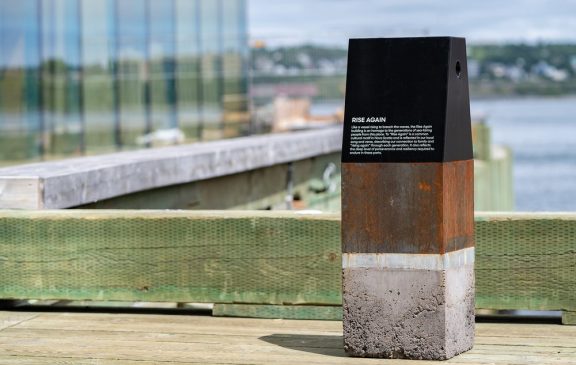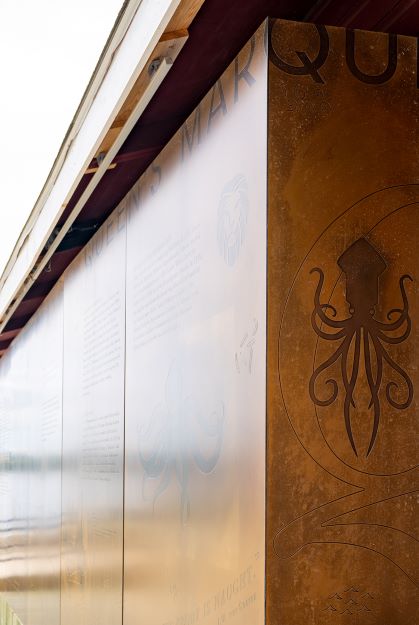Power of Place

Those with a deep connection to Nova Scotia share a unique lived experience. Pushed up against the sea, surviving on rugged land, Nova Scotians share the ability to come together, weather the storm and Rise Again.
Throughout Queen’s Marque, there are forms, art, materials, design and connection with the land and the sea that reflect this resilient Power of Place.

Born of this Place
Queen’s Marque could not exist in any other place – it is truly “Born of this Place”.
Inspired by history and tradition, drawing on the talents of local architects, consultants and builders to tell the story of Nova Scotia through form, materiality and craftsmanship.
Nodding to our past, yet completely contemporary.
Historic Vision

Nova Scotians are known storytellers – passing history and fables through generations. These stories shape our values and beliefs and define our character. Like the generations before us, we look to Rise Again while remembering and honouring our past.
The idea for Queen’s Marque was shaped by these stories from our past and the sense of opportunity we see in the future.
We Rise Again

Rise Again is a well-known refrain in Nova Scotia – representing the resiliency of Nova Scotians and their tenacious ability to overcome adversity and ‘rise again’.
Within the district, Rise Again is a structure unlike any other. The sloped roof ascends like a vessel from the sea, rising two stories above ground and offering a compelling and intimate view of Halifax’s renowned harbour. The roof acts as a public area, featuring wide timber stairs leading to the peak, and forms a natural amphitheatre to the public space at its base.
It is a ritualistic climb in homage to past generations that worked hard and struggled at times, to forge this place. Rising out of the water, the form is proud and hopeful, as is our city.

Democracy of Place
Balancing built forms with wide-open space, Queen’s Marque extends a warm welcome. Concerts, exhibits, festivals and events, a significant art collection and a burgeoning culinary scene – together create a place of community and gathering.
The Birth of Transatlantic Communication

The birth of transatlantic communication, connecting North America with Europe, is marked at Cable Wharf, the historic location where the first transatlantic cables were originally laid.
This important location is observed today by three large circular spools, clad in Muntz metal and marked with stories, quotes and images that tell the story of this historic foundational connection.
Queen’s Landing

Queen’s Landing – a rare place on the Halifax waterfront where you can dip your toes in the ocean, sit by the water with a cup of coffee or take off on a kayak or paddleboard.
Queen’s Landing is a true feat of engineering and design – ten massive granite steps, each weighing 20,000 pounds, were installed on top of 80,000-pound risers which were tamped down into the ocean floor.

North and South Gates
The North and South Gates are the entrances on either side of Queen’s Marque, leading from the George Street and Prince Street Plazas into the centre courtyard called Rise Again Square.
Each curved entryway is clad in Muntz metal, a metal that was originally used to protect the hull of ships on long ocean voyages.

The Bosque Gallery
The Bosque Gallery is a raised granite area inside Queen’s Marque that sits under twelve Autumn Blaze maple trees, a symbol of refuge and resilience.
Search the ground for Maritime symbols engraved on Muntz metal tiles and locate an original survey marker found during an excavation in the center of the Gallery.

The Chocks
The North, South and Centre Chocks are three entrances into Queen’s Marque district from Lower Water Street. They are named for the chocks, or supports, that traditionally cradle the hull of a ship.
Pause as you walk through these Chocks to find stories of legendary Nova Scotians etched on the Muntz metal panels.
The Capture of the USS Chesapeake

The battle with the Chesapeake was a brief but defining moment in the War of 1812. A short 15 minutes after it started, the Chesapeake’s mortally wounded Captain was brought below, and was heard to yell “Don’t give up the ship!” The crew of the Shannon had no intention of giving up their bounty, and embracing this rallying cry as their own, returned with great excitement, Chesapeake in tow, to Queen’s Landing.
The story may end there, but the legacy of the Chesapeake is a relationship built on mutual respect. The Chesapeake’s Captain, who died from injuries sustained during the battle, was interred with full military honours by the people of Halifax.
A Call to the Sea

There are legendary people who inspire us to see all the possibilities that lie within us, no matter how daunting or impossible our dreams may seem. In 1895, Nova Scotia-born mariner and adventurer Joshua Slocum set off on a solo journey of a lifetime and single-handedly made history.
Joshua set off alone on his adventure from the mouth of Halifax Harbour, using the old Sambro Lighthouse as his departure point to commence an around-the-world journey. He was armed with only a few charts, a one-dollar tin clock for navigation, and his stubborn resolve. At 51-years old, Joshua set forth, alone, with only the world ahead.
After 46,000 miles, and just over three years, Joshua returned safely to Newport, Rhode Island on June 27th, 1898, as the first person in history to circumnavigate the earth alone. Joshua’s account of his epic journey, Sailing Alone Around the World, published in 1900, was an instant bestseller.
Rum-Running
Nova Scotia’s fishing industry hit hard times at the end of the First World War in 1918 while prohibition hit hard across North America. Impoverished coastal communities dependent on fishing for survival saw some fishermen turn to rum-running as a resourceful, although illegal, way to economically weather the storm.

Rum running came naturally to Nova Scotians who, for the last two centuries, had carried goods to ports along the Eastern Seaboard of the United States. Now, however, their cargo included heavy kegs of rum, whiskey, and wine bottles wrapped in burlap bags.
Nova Scotia fishermen could make $35.00 a month when times were good. It was a lot of money and fortune was swift, but the risks were far greater. Rumrunners could be caught in unpredictable weather or run afoul of the law and be imprisoned. Despite these dangers, some 500 vessels in the Maritimes were engaged in rum-running by 1922.
Atlantic Fisheries Experimental Station

Throughout our history, Nova Scotians have understood that innovation and evolution were key to survival and prosperity. The Fisheries Experimental Station opened at Queen’s Landing in 1924. Nova Scotians developed technology to improve the handling, processing and quality of fisheries products in Atlantic Canada.
The scientists at the Experimental Station have been credited with advances that saved the fishery in the Maritimes, showing that with resilience and resourcefulness, we can Rise Again.
